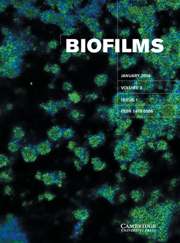Article contents
Molecular identification of species comprising an unusual biofilm from a groundwater treatment plant
Published online by Cambridge University Press: 01 January 2006
Abstract
Orica's groundwater treatment plant in Botany, NSW, Australia, was designed to remove and destroy volatile organic compounds from polluted groundwater and to treat the water for reuse on the Botany Industrial Park. The initial steps in this process involved acidification of the groundwater and air stripping. During this operation, very large quantities of a biofilm formed within the air stripper, necessitating weekly clean-outs. We investigated the composition of this biofilm using molecular methods. Total DNA extracted from biofilm material was used as a template for amplification of both bacterial 16 S ribosomal DNA (rDNA) and the eukaryotic rDNA internal transcribed spacer region. Cloning and sequencing of these products showed that the biofilm was composed primarily of a bacterium belonging to the genus Acidocella, a filamentous fungus (Trichoderma asperellum), and the ascomycetous yeasts Pichia, Candida and Geotrichum. This unusual biofilm was composed of acidophiles that were capable of rapidly generating large amounts of biomass under these conditions. When acidification of the groundwater ceased, the biofilm no longer formed.
- Type
- Article
- Information
- Copyright
- Copyright © Cambridge University Press 2007
References
REFERENCES
- 11
- Cited by


